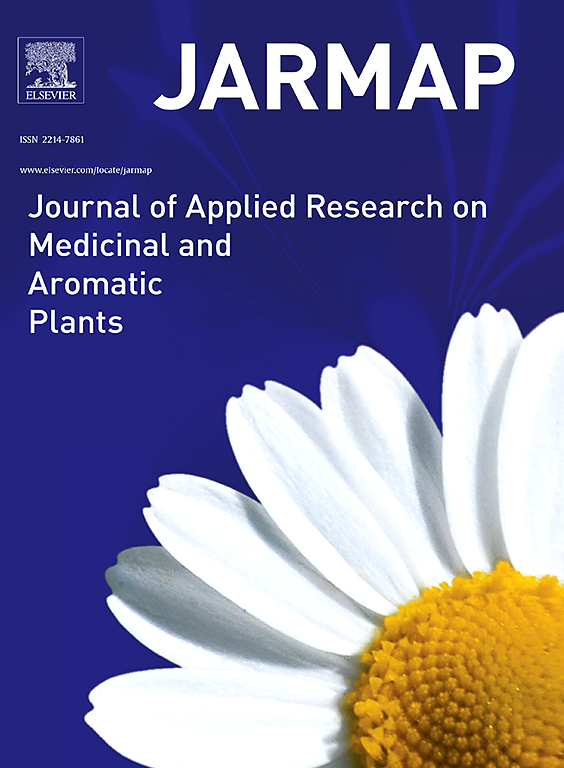评估泰国药用大麻品种 Hang Kra Rog Phu Phan 收获后生物质的增值成分
IF 3.6
2区 农林科学
Q1 PLANT SCIENCES
Journal of Applied Research on Medicinal and Aromatic Plants
Pub Date : 2024-10-29
DOI:10.1016/j.jarmap.2024.100593
引用次数: 0
摘要
泰国进行了监管改革,以促进药用大麻(Cannabis sativa L. )的种植和商业化。泰国的主要大麻品种是 Hang Kra Rog Phu Phan (HRPP),以四氢大麻酚(THC)含量高而著称。最近,该行业采用了生物循环方法,这反映了该行业致力于最大限度地减少损失和提高增值工艺。然而,有关这种大麻品种收获后管理产生的生物质以及增值产品开发的信息十分有限。本研究旨在通过对本地大麻农场进行调查,评估生产过程中产生的大麻生物质副产品材料的数量,从而弥补这一空白。调查显示,茎是产量最高的材料,其次是叶和根。随后对这些副产品进行了收集和化学成分检测。近似分析结果表明,干叶的蛋白质含量高达 19.27%,是三种生物质中最高的。脂肪、纤维、灰分和碳水化合物的成分因生物质类型而异。通过顺序萃取法发现,叶片材料中果胶的萃取率高达 13.82%,而茎秆部分的果胶萃取率为 13.02%。同时,根部的纤维素比例最高,达到 83.77%。使用微阵列分析法确认多糖成分后发现,这些生物质含有各种类型的多糖(果胶、纤维素、半纤维素)。生物活性化合物分析表明,叶片生物质中的总酚和总黄酮含量最高,分别为 11.57 毫克/克 DM 和 14.91 毫克/克 DM。叶片的抗氧化活性也最高。对叶片中代谢物的定量分析发现,迷迭香酸含量为 2.55 毫克/克 DM,儿茶素含量为 2.33 毫克/克 DM,香兰素含量为 2.32 毫克/克 DM,大麻素组中大麻酚(CBN)含量最高,为 2.63 毫克/克 DM。这项研究的结果可作为利用大麻生产过程中产生的生物质的指南,这些生物质可用于制药、食品和饲料用途。本文章由计算机程序翻译,如有差异,请以英文原文为准。
Evaluation of value adding components from postharvest biomass of Thai medicinal cannabis var. Hang Kra Rog Phu Phan
Thailand has undertaken regulatory reforms to facilitate the cultivation and commercialisation of Cannabis sativa L. for medicinal purposes. The prominent cannabis strain in Thailand is Hang Kra Rog Phu Phan (HRPP), distinguished for its high tetrahydrocannabinol (THC) content. The recent adoption of a biocircular approach within the industry reflects a commitment to minimising losses and enhancing value-added processes. However, there is limited information on biomass generation from the postharvest management of this cannabis strain and the development of value-added products. This study aims to address this gap by conducting a survey of local cannabis farms and evaluating the quantity of cannabis biomass by-product materials resulting from the production process. According to the survey, stems were the most abundant materials followed by leaves and roots. These by-products were subsequently gathered and examined for its chemical components. The results of proximate analysis highlighted that the dried leaves had a high protein content up to 19.27 %, the highest in three types of biomasses. The composition of fat, fibre, ash, and carbohydrates varies depending on the type of biomass. By using sequential extraction, it was found that the extraction yield of pectin in the leaf materials was as high as 13.82 %, and in the stem part, it was at 13.02 %. Meanwhile, cellulose was found in the highest proportion from the roots, at 83.77 %. Confirmation of the composition of polysaccharides using microarray profiling revealed that these biomasses contain various types of polysaccharides (pectin, cellulose, hemicellulose). Analysis of bioactive compounds revealed that the total phenolic and total flavonoid content were the highest in the leaf biomass, consisting of 11.57 and 14.91 mg/g DM, respectively. The leaves also had the highest antioxidant activity. Quantitative analysis of the metabolites in the leaves found contents of rosmarinic acid 2.55 mg/g DM, catechin 2.33 mg/g DM, vanillin 2.32 mg/g DM and in the cannabinoid group, the highest quantity of cannabinol (CBN) 2.63 mg/g DM was found. The findings from this study could serve as a guideline for utilising biomass generated from the production process of cannabis that could be used for pharmaceutical, food, and feed purposes.
求助全文
通过发布文献求助,成功后即可免费获取论文全文。
去求助
来源期刊

Journal of Applied Research on Medicinal and Aromatic Plants
Pharmacology, Toxicology and Pharmaceutics-Drug Discovery
CiteScore
6.40
自引率
7.70%
发文量
80
审稿时长
41 days
期刊介绍:
JARMAP is a peer reviewed and multidisciplinary communication platform, covering all aspects of the raw material supply chain of medicinal and aromatic plants. JARMAP aims to improve production of tailor made commodities by addressing the various requirements of manufacturers of herbal medicines, herbal teas, seasoning herbs, food and feed supplements and cosmetics. JARMAP covers research on genetic resources, breeding, wild-collection, domestication, propagation, cultivation, phytopathology and plant protection, mechanization, conservation, processing, quality assurance, analytics and economics. JARMAP publishes reviews, original research articles and short communications related to research.
 求助内容:
求助内容: 应助结果提醒方式:
应助结果提醒方式:


